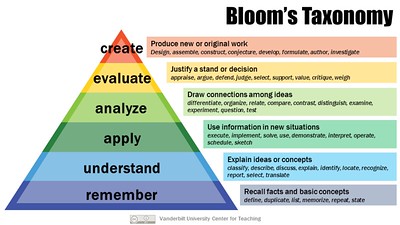Ontario Blind-Low Vision Early Intervention ProgramFunctional Vision Assessment Report
A downloadable form which report provides a description of how (child’s name) is currently functioning within each of the 10 CVI characteristics identified in the CVI Range (Roman, 2018). According to the CVI Range, (child’s name) has a range score of (add score 1-10) and is therefore considered in Phase (I, II OR III). Phase (I, II OR III) indicates that (child’s name) is (use wording from Phase Chart, i.e., ‘building visual behaviours’). The phase is not fixed, and with time and appropriate intervention, it is expected there will be further progress.
Information is gathered through interviews, observation and direct assessment of (child’s name) in (add his or her location, i.e. home, child care, preschool, OEYC – include all that).

Bloom’s Taxonomy Armstrong, P. (2010). Bloom’s Taxonomy. Vanderbilt University Center for Teaching.
In 1956, Benjamin Bloom with collaborators Max Englehart, Edward Furst, Walter Hill, and David Krathwohl published a framework for categorizing educational goals: Taxonomy of Educational Objectives. Familiarly known as Bloom’s Taxonomy, this framework has been applied by generations of K-12 teachers and college instructors in their teaching.
The framework elaborated by Bloom and his collaborators consisted of six major categories: Knowledge, Comprehension, Application, Analysis, Synthesis, and Evaluation. The categories after Knowledge were presented as “skills and abilities,” with the understanding that knowledge was the necessary precondition for putting these skills and abilities into practice. While each category contained subcategories, all lying along a continuum from simple to complex and concrete to abstract, the taxonomy is popularly remembered according to the six main categories.
